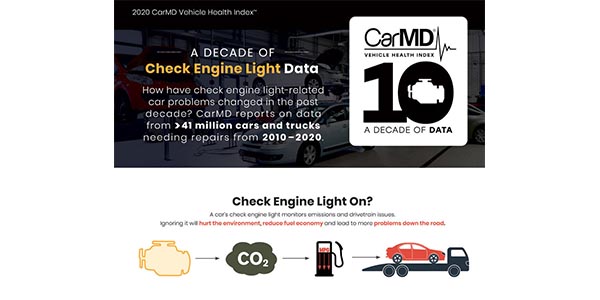CarMD.com Corporation, a leading provider of automotive diagnostic data and business solutions, recently released its 2020 CarMD Vehicle Health Index, marking 10 years since the first annual release of this report on check engine light-related repairs, costs and trends. The April 2020 report includes a year-over-year ranking of the 10 most common check engine light repairs and associated costs in the U.S., as well as a breakdown by region. The report also looks back on a decade of diagnostic data from more than 41 million unique vehicles to identify how the type and cost of repairs have changed as vehicles become more technologically advanced.
“Recognizing that the check engine light was often misunderstood and feared by vehicle owners, CarMD initially released its Vehicle Health Index to educate consumers about the importance of addressing the check engine light to minimize repair costs and maximize vehicle life,” said Ieon Chen, CEO, CarMD. “Over the last decade, this index has become the trusted authority on check engine light diagnostics for consumers and the automotive aftermarket industry as they track increases and decreases in particular repairs, identify emerging trends, adjust costs and forecast inventory accordingly. It is fascinating to see how the type and cost of car repairs have changed over the years as the number of sensors and subsequent fixes on most vehicles has nearly doubled.”

Today’s cars have more computerized sensors than ever before. In 2010 CarMD identified 675 different possible fixes for a check engine light. In 2019 that nearly doubled to 1,283.
The 2020 Index finds that for the first time since CarMD has reported these rankings, “replace catalytic converter” was the most common check engine light repair. Catalytic converters are costly repairs that don’t typically fail unless maintenance and other repairs like as a faulty oxygen sensor or ignition coil are ignored, or a vehicle has high mileage. This can be partially explained by the increase in average vehicle age from 11.7 years in 2018 to 11.8 years in 2019. Back in 2010 when CarMD first started publishing Vehicle Health Index data, the average vehicle age was 10.6 years old. The average cost to replace a catalytic converter on a vehicle in 2019 was $1,375; back in 2010 the same repair averaged $1,008. A common precursor to catalytic converter failures, “replace oxygen sensor” has ranked as the most common repair for eight of the 10 years this Index has been reported; in 2019 it was the second most frequently recommended repair.
Rounding out the five most common problems found to trigger the check engine light after 1) catalytic converter and 2) oxygen sensor were 3) ignition coil and spark plug, 4) gas cap and 5) mass air flow sensor. CarMD finds an increase in percentage of MAF sensors and fuel injectors needing replacement. Automotive aftermarket retailers and parts manufacturers can use this information along with other industry data to have meaningful discussions about inventory and parts forecasting.
A repair that has become less common over the last decade is to tighten or replace a gas cap. The gas cap accounted for 9.2% of repairs in 2010; this past year it only accounted for 4.5% of repairs. Increased consumer education about the role fuel caps play in vehicle emissions and fuel economy, combined with an uptick in capless gas tanks on newer vehicles, have contributed to this drop in gas cap-related CELs. Another repair with a marked increase in incidences is “replace ignition coil(s) and spark plug(s),” moving from no. 20 and 1.1% of repairs in 2010 to no. 3 accounting for 5.23% of repairs last year. This is an example of how ignoring a smaller problem like a spark plug can snowball into the need for more than one repair.
In 2019, the average cost to repair a check engine light issue in the U.S. was $384 – up just 1% from the previous year. Average overall labor expense per repair was down just over 5%, and parts costs were up about 6%. Car repair costs were up in three of four U.S. regions, with the exception being the Midwest where costs were down 1.6% over the past year. Several factors impact the type and cost of repairs, including vehicle age, driving conditions, upkeep and how often a driver addresses a dashboard warning light. Over the past decade, the lowest average repair cost was $305 in 2018; the highest average repair cost was $397 in 2016.
The 2020 CarMD Vehicle Health Index analyzed recommended repairs needed on more than 15.9 million in-use vehicles reported to and validated by CarMD’s network from Jan. 1, 2019 to Dec. 31, 2019. The full Index, including the 10 most common check engine-related repairs; top 10 Diagnostic Trouble Codes; 10-year history of U.S. car repair costs, list of most common repairs by region; 10 most common Network System Modules reporting issues; and 10 least/most expensive repairs is available at https://www.carmd.com/wp/vehicle-health-index-introduction/2020-carmd-vehicle-health-index/. Individual vehicle owners can see upcoming maintenance and common repairs by year, make, model and mileage with the free CarMD Garage online resource.


